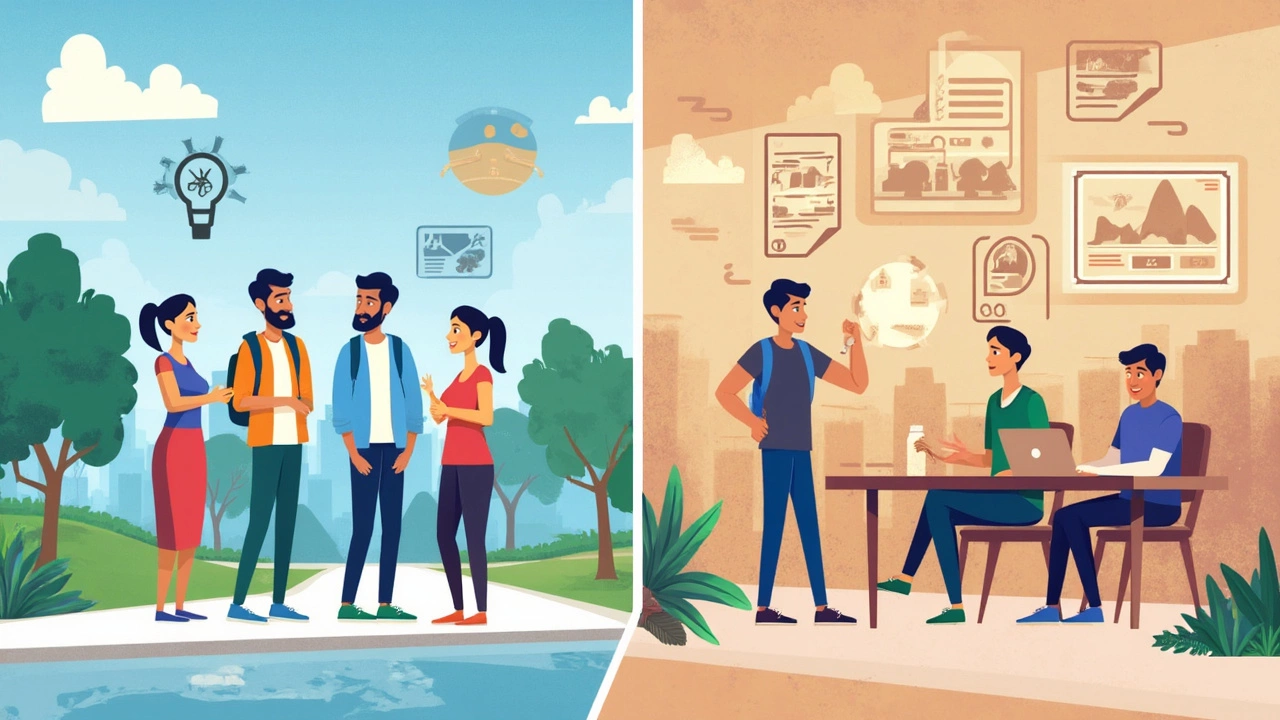If you're studying with the CBSE syllabus, the idea of leaving India for college in the USA probably feels like taking a massive leap. A lot of parents and students wonder if the hassle and the price tag are really worth it. Here’s the thing: US universities can actually be a better fit than you’d expect, especially for CBSE students who are solid with English and have tackled a demanding curriculum already.
Why does it matter? In the US, colleges really push you to think for yourself and connect what you learn in class to real-world stuff. You won’t just be memorizing definitions — you’ll do projects, debate ideas, and work on things outside textbooks. The move is less about escaping entrance exams and more about getting pumped to solve problems that don’t even have answers yet.
- CBSE Syllabus: Ready for the American Classroom?
- Learning That’s Not Just from Books
- Why Campus Life in the US Changes You
- Building a Career: Indian Degrees vs US Degrees
- Sorting Out Costs, Scholarships, and Admissions
CBSE Syllabus: Ready for the American Classroom?
A lot of students worry their Indian schooling won’t cut it in the US. The good news? Colleges in America are actually pretty familiar with the CBSE setup. In fact, loads of Indian undergrads get accepted every year from CBSE backgrounds—especially since the National Education Policy 2020 gave a boost to how the CBSE board matches global standards.
Here’s the reality: CBSE puts a real focus on science, math, languages, and logical thinking. Those are just the skills American colleges want. CBSE kids often do well on SAT and TOEFL tests because they’ve already tackled some tough English and analytical work at school.
"The CBSE curriculum is rigorous, and we've seen its students succeed at our university far above international averages." — Director of International Admissions, University of Southern California
What counts is how you prove it. Most US colleges have clear requirements:
- Send your study in USA transcripts and get them evaluated—usually through agencies like WES or ECE.
- Sit for the SAT or ACT (although nearly 80% of US colleges are now test-optional according to the National Center for Fair & Open Testing, 2025 update).
- Show English proficiency with scores from TOEFL, IELTS, or Duolingo.
Check out some real numbers:
| Requirement | CBSE Students Meeting Criteria (%) |
|---|---|
| English Proficiency (TOEFL ≥ 90) | 82 |
| SAT Math Scores ≥ 600 | 76 |
| Overall GPA Conversion (US Equiv. ≥ 3.2) | 69 |
CBSE students often hit these targets. If your basics are strong, you’ll handle assignments, classes, and group projects just fine. If numbers or essay writing are shaky, use the months before applications to upskill—there’s loads of time to practice online with free guides and sample papers.
Learning That’s Not Just from Books
Here’s a real difference: in the study in USA experience, you won’t just be memorizing notes. US colleges are famous for mixing up theory with hands-on learning. There’s a big focus on research, group projects, debates, and case studies. Professors ask you to speak up in class and actually care what you think. This approach suits CBSE students who are already used to some level of project work and public speaking, but it takes it to a whole new level.
If you join a US university, you’ll see lectures being mixed with lab sessions, hackathons, and real-life problem solving. For example, business students get to work with local start-ups, engineering students build robots or run experiments, and even arts majors land internships with museums or theaters. Instead of endlessly preparing for one final exam, your grades are often split between papers, presentations, midterms, and projects. This can take a lot of pressure off and help you develop actual skills.
Here’s a snapshot of how coursework gets divided in most US undergrad programs versus typical Indian ones:
| Aspect | US Colleges | Indian Colleges |
|---|---|---|
| Assessment Style | Projects, quizzes, presentations, continuous assessment | Mainly final exams, some internal tests |
| Class Participation | Emphasized and graded | Rarely graded, often optional |
| Research Opportunities | Common for undergrads | Mostly for postgrads, limited for undergrads |
| Internship Culture | Strong; built into many programs | Still growing; not core for all courses |
The point isn’t that Indian colleges are bad — it’s just that US colleges put you in situations where you have to stretch and get creative every semester. You get more feedback from professors, and there’s actually space to mess up, learn, and start over without one bad exam ruining your future.
One good tip: If you like the CBSE side of learning where projects matter, search for US universities that value your high school work. Some of them will even count your past leadership or research experiences when reviewing your college application.

Why Campus Life in the US Changes You
Campus life in the USA isn’t just about hitting the books. It’s a whole new world, and if you’ve grown up with the usual Indian school routine, it can feel like a giant reset button. Everything is designed to pull you out of your comfort zone and make you grow — fast.
First, let’s talk about what you actually get on an average US college campus. It’s not just classrooms and libraries. You’ll find sports centers that look like gyms from TV shows, career centers with real connections to companies, and tons of clubs — robotics, art, business, coding, you name it. This is where real learning happens. You might end up leading a group, organizing events, or even running for student government. Around 86% of US undergrads participate in extracurriculars, while the same number is much lower in India – probably under 30% in most government colleges.
Many international students say the biggest change is learning to be independent really fast. You have to handle laundry, bills, food — life skills that Indian students rarely get to practice at home. Here’s a quick look at just some differences:
| Campus Life Area | US Colleges | Typical Indian Colleges |
|---|---|---|
| Clubs & Activities | 500+ options at top campuses, lots open to all students | Usually 10-30 on average, mostly course-focused |
| Student Housing | On-campus for 1st year (sometimes full degree!), diverse roommates | Mostly off-campus/hostel, assigned by gender & year |
| Part-time Jobs | Allowed (on-campus), builds resume | Rare, often discouraged |
| Events & Networking | Career fairs, company meetups, speaker series | Mainly exam-related events, few outside companies |
What’s the takeaway? If you’re aiming for more than just grades, campus life in the USA gives you a launchpad to explore who you are and what you want to become. You learn to collaborate with all kinds of people. That’s why employers around the globe look for grads with this experience. If you want your study in USA plan to pay off, diving into campus life is a must — not just a bonus.
Building a Career: Indian Degrees vs US Degrees
Let’s be real: recruiters don’t treat all degrees the same, and that starts as soon as you graduate. A study in USA doesn’t just impress people on LinkedIn; employers know what that training means. American colleges are famous for hands-on learning — stuff like internships, research, and group projects actually counts toward your grade. In India, even the best colleges focus more on textbooks and written exams. That’s a big deal for your resume.
Check this table for a quick comparison:
| Factor | Indian Degree | US Degree |
|---|---|---|
| Teaching style | Mainly theory, lectures | Mix of theory, practice, and projects |
| Work experience during studies | Rare, usually after graduation | Internships and on-campus jobs are common |
| Flexible courses | Fixed subjects, set schedule | Pick majors and electives as you like |
| Employer recognition | Popular in local job market | Recognized worldwide |
| Networking | Mostly limited to professors, alumni | Meet people from all over the world; strong career fairs |
American employers often see US degree-holders as “job ready” because of their real-world experience before graduation. Even if you come back to India, having a US degree can fast-track your job hunt. According to a 2024 survey by QS, 85% of US university graduates found a job within six months, while it’s usually longer for Indian grads, especially from non-IIT colleges.
Here’s the downside: the process in the US is competitive. But the job support, from mock interviews to resume workshops, is on another level. Most big universities have career centers where the staff helps you snag internships, network with companies, and even write your first resume.
And what if you want to build a life outside India? Graduates from US universities have a head start with global companies. Indian firms like Infosys or TCS recruit US grads too, especially for international projects. Even US tech giants in Bangalore or Hyderabad are often led by people with US degrees.
To sum up: a degree from a good US college can be a game changer, not just for jobs in America but also for career growth in India and abroad. You’ll build contacts, grab internships, and have more choices if you ever want to switch fields later.

Sorting Out Costs, Scholarships, and Admissions
Let’s face it, study in USA sounds expensive. Most people instantly think of crazy high tuition or worry about how parents will manage the bills. Here’s the truth: there’s a wide range depending on the college you choose—like, huge differences. Public universities could cost around $25,000–$35,000 per year for tuition, while top private ones can charge upwards of $60,000. But tons of Indian students manage this every year, thanks to a bunch of smart moves.
First up—don’t let sticker prices scare you. Most colleges offer merit and need-based scholarships. Think of them as discounts for good grades, test scores, or cool extracurriculars. There are actually schools that give 100% need-based aid to admitted international students, like Harvard and MIT, but even plenty of state universities have awards that can knock off thousands per year.
How to land a scholarship? Here are some simple tips:
- Start hunting early—don’t wait for admit letters before looking at scholarship deadlines.
- Show off more than just grades. Leadership roles, sports, or volunteering really matter.
- Write honest, personal essays. Admissions counselors would rather read about your actual mess-ups and lessons, not just perfect scores.
- Shortlist places that offer aid, like Stony Brook (SUNY), Arizona State University, or the University of Texas at Austin.
Let’s talk admissions. Unlike India, US colleges look at the full picture. You’ll usually need:
- CBSE or equivalent academic records (transcripts)
- SAT or ACT scores (though many colleges are now ‘test-optional’—seriously!)
- Proof of English ability, like TOEFL or IELTS
- Personal statement/essays
- Recommendation letters from teachers
- Extracurricular activities
Here’s a quick look at sample costs and common scholarships (per year):
| University | Tuition Fees (USD) | Scholarship Opportunities |
|---|---|---|
| UCLA (Public) | ~$47,000 | Merit scholarships up to $20,000/year |
| Purdue University (Public) | ~$29,000 | International student awards up to $10,000/year |
| NYU (Private) | ~$60,000 | Need-based aid, average grant $31,000 |
| University of Texas at Austin (Public) | ~$40,000 | Recruitment scholarships $5,000–$10,000/year |
One more tip: after scholarships, the real game is showing you can pay what’s left. Work part-time jobs on campus (usually up to 20 hours/week) or grab paid internships in summers. Both help manage living costs and let you build a résumé for post-study work options.
